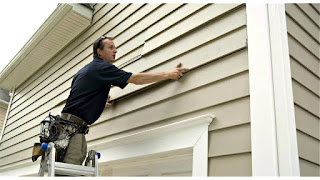Siding Installation: A Comprehensive Guide to Transforming Your Home’s Exterior
Siding Installation: A Comprehensive Guide to Transforming Your Home’s Exterior
Blog Article
Siding is amongst the most important components of your home’s exterior. Not only does it contribute to the aesthetic benefit of your house, it also protects it through the elements, improves energy efficiency, and increases the overall worth of your property. Whether you are considering installing siding the first time or replacing worn-out siding, learning the process and options available will ensure an effective project.
What is Siding?
Siding will be the material placed on the exterior of your house or building. It serves both as a protective layer and like a decorative feature. Common materials useful for siding include wood, vinyl, fiber cement, metal, and stone. Each material possesses his own advantages, costs, and installation requirements.
Why Choose to Install Siding?
Siding provides numerous benefits for your house, including:
Protection: It shields your property from harsh climate such as rain, snow, wind, and extreme temperatures.
Energy Efficiency: Properly installed siding can improve insulation, assisting to regulate indoor temperatures minimizing heating and cooling costs.
Aesthetic Appeal: Siding increases the curb benefit of your home, offering a new and modern look.
Durability: High-quality siding materials can last for many years, adding long-term value to your property.
Low Maintenance: Some siding materials, like vinyl, have become low-maintenance, requiring nothing but occasional cleaning.
Types of Siding Materials
There is really a wide range of siding materials to select from. Each material features its own distinct look, benefits, and drawbacks. Let’s explore some of the most common options:
Vinyl Siding
Pros: Cost-effective, low-maintenance, for sale in many colors and styles, resists fading, while offering a variety of textures.
Cons: Can crack in extremely cold temperatures and may even not be as durable as other materials.
Cost: Typically the most affordable option.
Wood Siding
Pros: Timeless, natural aesthetic, eco-friendly, which enable it to be stained or painted to complement any home design.
Cons: Requires more maintenance (e.g., painting, sealing), susceptible to pests like termites, and will rot or warp otherwise properly maintained.
Cost: Mid-range pricing, but higher maintenance costs.
Fiber Cement Siding
Pros: Highly durable, fire-resistant, and can mimic wood or stone appearance. Requires minimal maintenance.
Cons: Heavier material, requires professional installation, which enable it to be more expensive than vinyl.
Cost: Higher upfront cost, but long-term durability might make it a smart investment.
Metal Siding (Aluminum or Steel)
Pros: Long-lasting, resistance against pests and rot, and low-maintenance. Aluminum siding can also be lighter than steel.
Cons: Can dent easily, especially aluminum, and may even not provide the maximum amount of insulation as other materials.
Cost: More expensive than vinyl, but offers great longevity.
Stone and Brick Veneer Siding
Pros: Aesthetic appeal, durable, resistant against fire and pests.
Cons: Expensive and needs professional installation.
Cost: One from the most expensive options.
Siding Installation Process
Installing siding is a detailed and time-consuming project that should ideally be handled by professionals, however some homeowners might want to tackle it themselves. The installation process typically requires the following steps:
Preparation and Removal
Before installing new siding, any old siding or materials are removed, along with the house is prepped. This includes inspecting the present walls for damage, checking for moisture or mold, and repairing any issues.
Installation of Insulation or House Wrap
Once the wall is prepped, insulation or house wrap (a protective barrier that keeps moisture out) can often be installed to boost energy efficiency. This layer helps to regulate the temperature in the home while protecting against moisture buildup.
Starting with the Bottom
Installation generally begins on the bottom of the home and works upwards. This means that each row of siding overlaps the main one below it, allowing water to circulate down and from the surface.
Attaching the Siding
Depending for the material, siding is either nailed, screwed, or fastened with clips. For some materials, like vinyl or fiber cement, specific tools must ensure precise placement.
Trimming and Finishing Touches
Once the majority of the siding is installed, trim pieces are added around windows, doors, corners, and in the roofline. These details not merely improve the look but also provide extra protection from the elements.
DIY vs. Professional Installation
While some homeowners select DIY siding installation, it really is generally recommended to rent a professional contractor. Here’s why:
Experience and Skill: Professional contractors possess the experience to be sure the siding is properly installed and weatherproofed. They are also acquainted with local building codes.
Tools and Equipment: Specialized equipment are often required to install siding correctly, particularly for materials like fiber cement and metal.
Safety: Siding installation can be dangerous, specially when working on high walls or roofs. Professionals are equipped to deal with such tasks safely.
Warranties: Many siding manufacturers offer warranties for professional installations, providing peace of mind in case any issues arise.
Cost of Siding Installation
The tariff of siding installation can vary significantly depending around the material chosen, the size of the home, and labor costs. On average, homeowners can get to pay anywhere from $5,000 to $15,000 or more for siding installation. Vinyl siding is commonly the most economical, while stone veneer and fiber cement are on the higher end from the price range.
Factors that Influence Cost:
Material Type: Vinyl and wood are usually the least expensive, while fiber cement, metal, and stone might be pricier.
Home Size: Larger homes require more materials and labor, improving the total cost.
Installation Complexity: If your property has intricate architectural details, it might require more labor-intensive installation, adding to the cost.
Fiber Cement Siding San Antonio is a superb way to enhance the look, efficiency, and durability of your own home. Whether you decide on vinyl, wood, fiber cement, or other material, proper installation ensures that you get the absolute maximum benefits. With careful consideration of one's budget, home design, and long-term maintenance, siding could be a valuable investment that pays off for years to come.